What Does It Mean to Be an American? - 1918
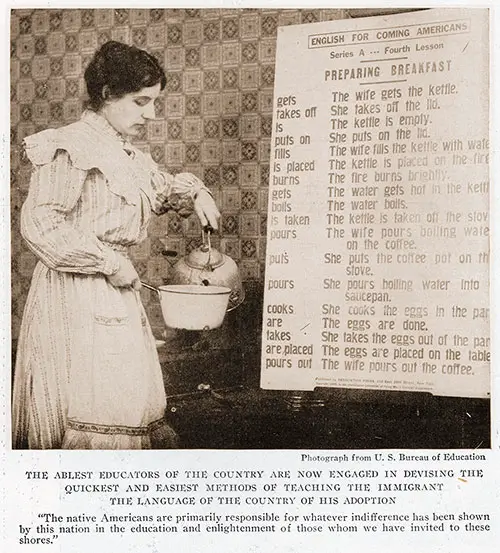
The Ablest Educators of the Country Are Now Engaged in Devising the Quickest and Easiest Methods of Teaching the Immigrant the Language of the Country of His Adoption. “the Native Americans Are Primarily Responsible for Whatever Indifference Has Been Shown by This Nation in the Education and Enlightenment of Those Whom We Have Invited to These Shores.” Photograph from U. S. Bureau of Education. The National Geographic Magazine, April 1918. GGA Image ID # 1864dd4733
What is it to be American? We say that it is to love the Stars and Stripes. But a flag is no more than a symbol. It represents hopes and fears, struggles and achievements, something done and something yet to be done.
THE REAL STORY OF AMERICA
The story of America is not to be told in the landing of the Pilgrim fathers, the fights with the Indians, Bunker Hill and Yorktown, Gettysburg and Appomattox, Santiago and Manila; nor is the story told in the advance of the pioneer from the Atlantic to the Pacific, in the building of great railroads and the conquering of the wilderness, in the searching of the mountains and the establishing of great industries, in the coming of the immigrant, or in the philosophy of Emerson and of James, or the poetry of Whitman and PoE, in the inventions of Whitney and Edison—not even in the lives of our great leaders.
All these are expressions of the American spirit of adventure, of purposeful searching after the thing that is better. It is an expression of a divine dissatisfaction. It may be that this nation, like all others, will come to a period of decline. We cannot expect to live forever. But if we do come to such a period, it will be because we rest content.
We are trying a great experiment in the United States. Can we gather together people of different races, creeds, conditions, and aspirations who can be merged into one? If we cannot do this, we will fail ; indeed, we will have already failed.
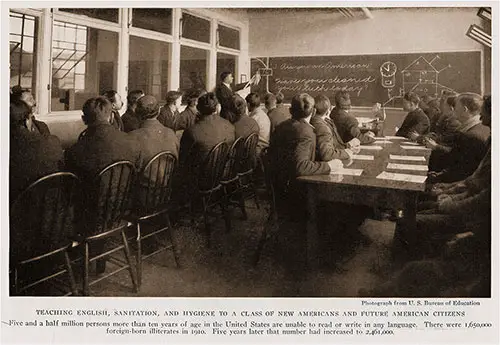
Teaching English, Sanitation, and Hygiene to a Class of New Americans and Future American Citizens. Five and a Half Million Persons More Than Ten Years of Age in the United States Are Unable to Read or Write in Any Language. There Were 1,650,000 Foreign-Born Illiterates in 1910. Five Years Later That Number Had Increased to 2,461,000. Photograph from US Bureau of Education. The National Geographic Magazine, April 1918. GGA Image ID # 1863cbfa82
Making America the Greatest of Nations
If we do this we will produce the greatest of all nations, and a new race that will long hold a compelling place in the world. It is well, therefore, that we come together at such times of stress as this, and we should have come together long since, and put our heads to the problem as to what are the initial steps in bringing about that harmony within our country which will give it meaning, purpose, and cohesion.
We should not be moved to this by fear. There is nothing to fear. Our wars have been fought by men of foreign birth—Irishmen, and Germans, and Swedes, and Scotchmen. We see their names every day in the list of those who are dead on the Battlefields of France.
There is no such thing as an American race, excepting the Indian. We are fashioning a new people. We are doing the unprecedented thing in saying that Slav, Teuton, Celt, and the other races that make up the civilized world are capable of being blended here, and we say this upon the theory that blood alone does not control the destiny of man; that out of his environment, his education, the food that he eats, the neighbors that he has, the work that he does, there can be a formed and realized spirit, an ideal which will master his blood. In this sense we are all internationalists.
Some Unpleasant Discoveries
Now there are several things which we have come upon recently which seem to be discoveries to those of us who have not been wise.
The first is that we have a great body of our own people, five and a half millions, who cannot read or write the language of this country. That language is English. And these are not all of foreign birth. A million and a half are native born.
The second is that we are drafting into our army men who cannot understand the orders that are given them to read.
The third is that our man power is deficient because our education is deficient.
The fourth is that we, ourselves, have failed to see America through the eyes of those who have come to us. We have failed to realize why it was that they came here and what they sought. We have failed to understand their definition of liberty.
To be an American is not to be the embodiment of conceit as to all things that are fundamental in America, or to be satisfied with things as they are, or to let things drift.
We are taking a leaf out of Germany’s book in many ways these days.
Our ways of war must conform to her processes of destroying human life. She has made herself a composite, compact, purposeful nation by methods of education as well as by authority. We can make ourselves a composite, purposeful nation and impose no authority, other than the compelling influence of affection, sympathy, understanding, and education.
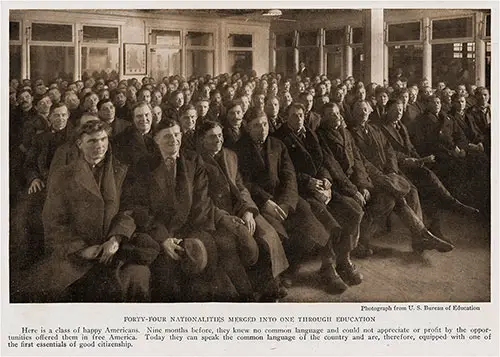
Forty Four Nationalities Merged Into One Through Education. Here Is a Class of Happy Americans. Nine Months Before, They Knew No Common Language and Could Not Appreciate or Profit by the Opportunities Offered Them in Free America. Today They Can Speak the Common Language of the Country and Are, Therefore, Equipped With One of the First Essentials of Good Citizenship. Photograph from US Bureau of Education. The National Geographic Magazine, April 1918. GGA Image ID # 1863f8f62f
The Responsibility of the Hour
Out of this conference should come not a determination to make more hard or difficult the way of those who do not speak or read our tongue, but a determination to deal in a catholic and sympathetic spirit with those who can be led to follow in the way of this nation, and as to those others who cannot, other procedure must be applied. The keynote of this conference is “our responsibility.”
It is now a year since we entered into this war, and our men are standing shoulder to shoulder with Frenchmen on their right and Englishmen on their left, holding the line that is to save civilization.
The war is coming nearer and nearer to us each day. Each morning we turn with anxious and with proud eyes to read the list of our own heroes who have made the supreme sacrifice.
In a few days more this list will swell from a few short inches into continuing columns and pages. Then we will first clearly see the horror of this war.
And then there will surge through our souls a passion of indignation and outrage that will close our ears to talk of peace and fix our will to win.
Where Streams Run Red With Blood
For now almost four years we have been looking afar off at a series of unprecedented battles, in every one of which more men were killed than all the joint participants in either Waterloo or Gettysburg.
There is hardly a stream in northeastern France, hardly a village, that has not been given a permanent name in history as the center of a great battle.
For many days now the Germans have been advancing upon Amiens, another of the historic cathedral towns of France. This time the Kaiser himself has announced to the world that he would be present and in supreme command.
There has been no such battle before. Let us hope there may never be such another.
The determination of the Germans has been shown in their unprecedented recklessness of life. Amiens, the great railroad center leading from Calais to Paris, must be seized.
There never has been greater courage shown by men than the Germans have shown in this advance.
The men march in solid ranks and are mowed down by rapid-fire guns. As the front line falls the rear advances. As it falls, too, another line appears to take its place. And so by increments of death the Kaiser wins his way.
The World’s Greatest Battle, but Not the Last
This is the world’s greatest battle. More men are involved, more cannon— they say there is a gun for every 40 feet along the western front—more airplanes, more tanks, more lethal weapons of every kind, more poisonous gases, and more of hell is seen upon that 60-mile front than the eyes of the angels have ever looked upon before.
We call it the world’s greatest battle, but the last great battle of this war has not been fought and cannot be fought now.
That line may bend, but it will not break. Remember, there are Scotchmen there—Scotchmen from Glasgow and from Edinburgh and from the far islands of the north, Scotchmen who never surrender; and Englishmen from Liverpool and Manchester and London, from the Soft Lake country and from Surrey; and Irishmen from Killarney, the gallant Irish, who are fighting that there may be an Ireland saved to which will come home rule; and men from Australia and New Zealand; Canadians, who love war no more than we do, but can make it just as well.
There are Frenchmen there, the Frenchmen of Verdun. Need I say more? No more can be said.
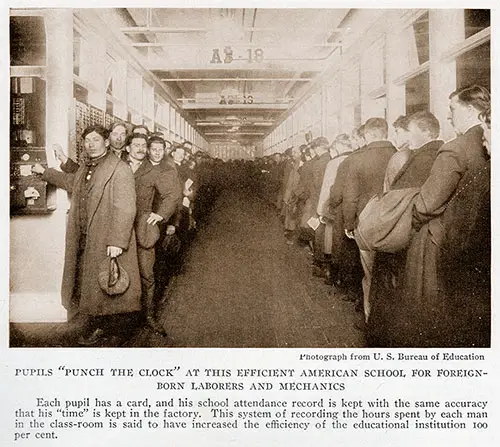
Pupils "Punch the Clock" at This Efficient American School for Foreign-Born Laborers and Mechanics. Each Pupil Has a Card, and His School Attendance Record Is Kept With the Same Accuracy That His “Time” Is Kept in the Factory. This System of Recording the Hours Spent by Each Man in the Class-Room Is Said to Have Increased the Efficiency of the Educational Institution 100 Percent. Photograph from the US Bureau of Education. The National Geographic Magazine, April 1918. GGA Image ID # 1863fff571
More to Live and Die for Than Ever Armies Had Before
Those men do not yield. They have not fought for nearly four years that they may crumple up now.
It is a thin line that holds the Kaiser back, but it is a line in which there is more of spirit and more of resolution than in any line the world has seen, because it has more to live for and more to die for than any other group of men ever gathered together; and into this thin line we are weaving our men in khaki.
These are but an assurance. More and still more are to follow, until that thin line is made a thick line.
Von Hindenburg said after the first week of the offensive that the first act was over. It is never the first act that tells the story.
The climax comes in the closing scene, and in that closing scene America will play her part ; and it will be a noble part. It is my solemn conviction that when success comes to the Allied armies, under General Foch, it will come because of what we do, because of our men in the field, and the spirit and sacrifice of our men and women and our boys and girls at home.
A New Spirit in America
America has never sought to be a world power. She does not now.
But America has nothing to live for if Germany becomes the one dominant power of the world. And against that possible day your boys and my boy must give their lives, their ambitions, their dreams, if need be.
And we who are not permitted to fight, what shall be our part?
Let it be our resolution that when our sons return they shall find a new spirit in America, a deeper insight into the problems of a striving people, a stronger, firmer, more positive and purposeful sense of nationality.
We shall make America better worthwhile to Americans and of higher service to the world.
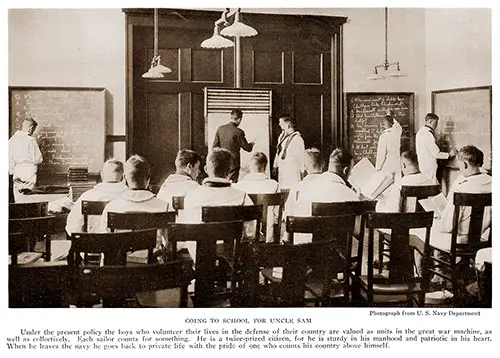
Going to School for Uncle Sam. Under the Present Policy, the Boys Who Volunteer Their Lives in the Defense of Their Country Are Valued as Units in the Great War Machine, as Well as Collectively. Each Sailor Counts for Something. He Is a Twice-Prized Citizen, for He Is Sturdy in His Manhood and Patriotic in His Heart. When He Leaves the Navy, He Goes Back to Private Life With the Pride of One Who Counts His Country Above Himself. Photograph from US Navy Department. The National Geographic Magazine, April 1918. GGA Image ID # 186408e896
What is it to be American? in The National Geographic Magazine, Washington, DC: National Geographic Society, Vol. XXXIII, No. 4, April 1918, pp. 351-353.
